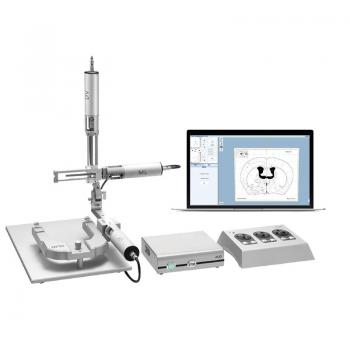/ Catalog / Stereotaxis / Automated RWD 71000
71000 Automated Stereotaxic Instrument
The RWD 71000 Automated Stereotactic Device allows precise setting of the coordinates of instrument movement by means of a computer.
- Overview
- Specifications
- References
- Links
The RWD 71000 is a brand-new automated intelligent stereotaxic device that is controlled by a computer. The correct position is guaranteed by its high accuracy (1 μm). When an atlas is incorporated, researchers can view the probe's position in relation to the relevant brain region. It is convenient and effective, simple to use, and may significantly reduce errors and damage caused by human operation. Built-in software with three automated processes (skull window, tissue removal, and multi-point programs). Also, the motional collision prompt function reduces the risk of animal injury from erroneous movement.
Key Benefits
1. A 3D display and an integrated rat and mouse brain atlas can help pinpoint the desired brain region precisely and rapidly.
- Computer Control
- Brain Atlas Integration
- Intuitive Navigation
2. Many experimental needs can be satisfied by automated task programs as the tissue removal, skull window, and multi point programs.
- Experiment Planning
- Avoids Human Errors
- Define/Store Targets
- High Throughput
3. Choose Bregma with a single click and a resolution of 1 micron.
- Bregma Setting
- Ultra-Precise
4. There are three different control options, including keyboard control, PC software, and a micromanipulator.
- Convenient
- Time-Saving
The instrument was used in these investigations:
- blocks bursting in the lateral habenula to rapidly relieve depression.
Yang Y, Cui Y, Sang K, Dong Y, Ni Z, Ma S, Hu H.
Nature. 2018 Feb 14;554(7692):317-322. - Astroglial Kir4.1 in the lateral habenula drives neuronal bursts in depression.
Cui Y, Yang Y, Ni Z, Dong Y, Cai G, Foncelle A, Ma S, Sang K, Tang S, Li Y, Shen Y, Berry H, Wu S, Hu H.
Nature. 2018 Feb 14;554(7692):323-327. - The interhemispheric CA1 circuit governs rapid generalisation but not fear memory.
Zhou H, Xiong GJ, Jing L, Song NN, Pu DL, Tang X, He XB, Xu FQ, Huang JF, Li LJ, Richter-Levin G, Mao RR, Zhou QX, Ding YQ, Xu L.
Nat Commun. 2017 Dec 19;8(1):2190.
You can also visit site of the manufacturer.


